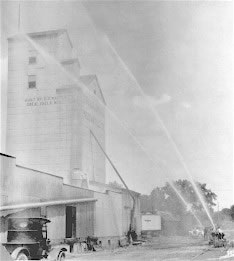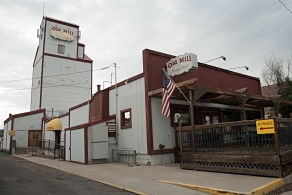Columbine Mill
Local Landmark—1994

Volunteer Fire Department practice at the Columbine Mercantile Co., 1924.
At 5798 South Rapp Street sits one of Littleton's oldest and most historic buildings. Historically, it was known as simply theColumbine Mill.
It was never actually named the Columbine Mill, that's just what everyone called it. Originally built in 1901 on land that had been homesteaded by Littleton's founder, Richard Little, it was a grain elevator for the storage and shipping facility for the Rough and Ready Flour Mill, which had originally been built by Little in 1867. In 1918, the building was acquired by the Columbine Grange of Littleton and organized as the Columbine Mercantile Company.
The grain elevator and mill were often one of the most important buildings to an agricultural community. The Columbine, at the time of its construction, was the only one to serve western Arapahoe and Douglas counties. Frequently towns achieved growth and dominance over other communities if they were fortunate to have and elevator, particularly if it was on an active railroad line. This was certainly the case for Littleton, whose agricultural economy boomed at the turn-of-the-century. The importance of mills and grain elevators to agricultural communities was always underscored by the potential to quickly loose them to fire. Grain dust is highly flammable and many communities lost these valuable agriculture assets to fire. Littleton lost its Rough and Ready mill to fire on July 9, 1959. Because of their flammability, historic elevators along the front range and eastern plains have become a very rare building type.

Columbine Mill, 2015. Photo by Amelia Martinez.
The building is a timber frame, metal clad structure with corrugated metal cladding. The elevator's second story and bins are stacked wood construction. The elevator has a gabled roof and series of one story, flat roof additions to the west. The one story mercantile is wood sided and has a false front at the entrance. There is a shed roof addition to the north of the elevator, as well as one on the east.
In 1920, the Mercantile absorbed the Arapahoe Milling and Elevator Company, which had acquired all the machinery for a flour mill but not the building. The Arapahoe's equipment was installed in the Mercantile building and the "Columbine Mill" began operation. Soon the Denver and Rio Grande Railroad ran a spur line to the elevators and the Mercantile thrived. At least 64,000 bushels of wheat were shipped in 1921.
In 1934 the business' name changed to the Columbine Fuel and Feed Company, showing an expansion of services and confirmation of the growing reliance of Littletonites on fossil fuels. By 1958, probably due to competition from specialized oil companies, a new owner reverted to the old business and changed the name to the Littleton Flour Mill. The Littleton City Directory listed the Mill as a feed company from 1961 to 1971, but by 1975, after a series of owners, the building was left vacant.
Next, beginning in 1979, a series of restaurants occupied the old mill building, each with varying degrees of success. There was Professor Plum's Restaurant and Lounge, Gustie's Little Italy and Rappscallion's. Finally, in 1994, the City of Littleton designated the old Columbine Mill as an historic landmark, acquired a grant from the State Historic Fund for restoration and, with new owners, converted it into a micro brewery and restaurant. The brewery and restaurant closed in 2015. In 2017 the building was bought by Francois Safieddine, the founder of the View House restaurant chain. According to Safieddine, there are plans to eventually revamp the building.
Bibliography
Littleton History Museum. "City Boards and Programs: Historical Preservation Board: Columbine Mill, South Rapp Street". Littleton: The Museum, 1992.
____. Photographic Archives.
____. Vertical File: "Columbine Mill".
Littleton Independent. Littleton Independent Publishers, 1888- .
Lobato, Rudolph. An Architectural and Historical Building Survey: Inventory and Evaluation, Littleton, Colorado. Littleton: Littleton Area Historical Museum, 1972.
Inventory Sources:
Arapahoe County Assessors Records
Littleton Historic Museum Files
Littleton Independent, 22 July 1938, 4 March 1976, 29 November 1977, 28 September 1978,
2 October 1986, 13 December 1990
Colorado Cultural Resource Survey Inventory Form, 5AH195, 10 August 1982
Denver Post, 13 April 1997
Sanborn Fire Insurance Maps 1914-1949
Littleton City Directories, 1932-1961
Treece, Thomas K. "The Columbine Mille," Manuscript, 14 April 1995
Littleton Independent and Arapahoe Herald, 7 January 1921, 22 April 1921 and 21 August 1921
Littleton City Directory, 1934
Photographs courtesy of the Littleton Museum unless otherwise noted. To order copies, contact the museum at 303-795-3950.
Compiled by Pat Massengill
Edited by Kris Christensen, Colorado Digitization Project
Updated March 2021